
Though the first surviving evidence or rice cultivation is from China, rice itself, and its cultivation, may have originated in India or Southeast Asia. It has been cultivated far too long to know for sure. India does have a wider variety of rice under cultivation than other parts of Asia. Rice grown in Pakistan is similar to that grown in northern India. Some unique varieties are grown in the foothills of the Himalayas. Completely different varieties are grown in the far eastern and southern reaches of India. Varieties grown in Sri Lanka (Ceylon) are very similar to those grown in the southeastern Indian state of Tamil Nadu.
The photo to the left is of a plant scientist photographically recording rice growth in a saline soil test plot in Balari, Karnataka. Photo by Amrut Morade distributed under license Creative Commons Attribution-ShareAlike v4.0 International.
General Information on Rice, and Rice
of other regions.
In India, due to the cost of cooking fuel, pressure cookers are very popular, and rice is often cooked in a pressure cooker, but cooking times on this page are for Rice Cooker or Stovetop Absorption Method. Measures are in Standard American cups (8 oz / 237 ml) not in Japanese Rice Cooker cups (180 ml / 6 oz).
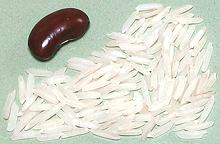 Grown in northern India and Pakistan, in the foothills of the Himalayas,
the "Queen of Fragrance" is a long grain distinctly aromatic rice that
stands up well to robust flavors. The grains are very long and properly
cooked stay very separate and fluffy. A number of varieties are
imported from India and Pakistan, so adjustment of the amount of water
may be needed one to another. Typically 1 cup of rice takes 1-7/8 cups
of water and makes 3 cups. The photo specimens were typically 0.290
inch long by 0.060 inch wide (7.4 x 1.5 mm). The grains expand greatly
in length when cooked. The photo specimens cooked out to about 1/2
inch long (13 mm).
Grown in northern India and Pakistan, in the foothills of the Himalayas,
the "Queen of Fragrance" is a long grain distinctly aromatic rice that
stands up well to robust flavors. The grains are very long and properly
cooked stay very separate and fluffy. A number of varieties are
imported from India and Pakistan, so adjustment of the amount of water
may be needed one to another. Typically 1 cup of rice takes 1-7/8 cups
of water and makes 3 cups. The photo specimens were typically 0.290
inch long by 0.060 inch wide (7.4 x 1.5 mm). The grains expand greatly
in length when cooked. The photo specimens cooked out to about 1/2
inch long (13 mm).
Basmati Aged is preferred to new because the grains stay even
more separate. It is aged before milling. A prime grade 50 year old
basmati can sell at over $100/pound to connoisseurs, but most is aged
just a year or two and is very affordable in North America, though
considered expensive in India. Japanese and Koreans do not like
basmati rice one bit, aged or not.
 This is simply Basmati Rice that has been par boiled in the husk before
milling. It is very popular in India and Nigeria, and widely available in
North America. It takes just a little more time time to cook than regular
Basmati, and a little more water (2 cups water to 1 cup rice). It is quite
tolerant of cooking conditions and the grains remain very separate even
if somewhat over cooked. Flavor has a definite hint of brown basmati. The
photo specimen grains were typically 0.340 inch long and 0.075 inch wide
(8.6 x 1.9 mm) and it cooked out to about 0.55 inch long (14 mm).
This is simply Basmati Rice that has been par boiled in the husk before
milling. It is very popular in India and Nigeria, and widely available in
North America. It takes just a little more time time to cook than regular
Basmati, and a little more water (2 cups water to 1 cup rice). It is quite
tolerant of cooking conditions and the grains remain very separate even
if somewhat over cooked. Flavor has a definite hint of brown basmati. The
photo specimen grains were typically 0.340 inch long and 0.075 inch wide
(8.6 x 1.9 mm) and it cooked out to about 0.55 inch long (14 mm).
 This rice doesn't seem to be much used in India, but it is exported to
North America where it is definitely used. The photo specimens were
typically 0.290 inch long by 0.060 inch wide (7.4 x 1.5 mm). This rice
takes more water and longer cooking than the white. For a cup of rice use
2 cups of water and cook for 50 minutes, then let rest 5 minutes before
lifting the cover.
This rice doesn't seem to be much used in India, but it is exported to
North America where it is definitely used. The photo specimens were
typically 0.290 inch long by 0.060 inch wide (7.4 x 1.5 mm). This rice
takes more water and longer cooking than the white. For a cup of rice use
2 cups of water and cook for 50 minutes, then let rest 5 minutes before
lifting the cover.
 [Rice Flakes, Pounded Rice; Poha (India); Choora (India, Northeast);
Chira (Assam)]
[Rice Flakes, Pounded Rice; Poha (India); Choora (India, Northeast);
Chira (Assam)]
This product is popular in India. The grains are cooked, flattened into
flakes and dried, making a product that cooks very quickly - an attractive
feature in a region where cooking fuel is extremely expensive. It is usually
given a quick rinse, drained well, and let sit for a few minutes to absorb
water that adheres to it.
 [Himalayan Red Rice - Short Grain]
[Himalayan Red Rice - Short Grain]
This is the staple rice of Bhutan in the Himalayas. It is a medium grain
rice sold "brown" with the reddish brown bran layers still on. It cooks a
little more quickly than other brown rice varieties, about 25 minutes
with 1-3/4 cups of water. The photo specimen grains were typically 0.225
inch long and 0.100 inch wide (5.7 x 2.5 mm).
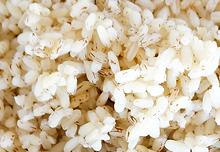 [Ukade rice] This is a par boiled rice, boiled in the husk, then
dried and milled. It is not easily available in North America. I find
appearance and descriptions very like Rose Matta
which is grown down the coast in Karala. The photo specimen is cooked, so
it is much lighter in color than our photo of Rose Matta, but both cooked,
they look very much the same.
Photo by Fredericknoronha distributed under license
Creative Commons
Attribution Share-Alike v4.0 International.
[Ukade rice] This is a par boiled rice, boiled in the husk, then
dried and milled. It is not easily available in North America. I find
appearance and descriptions very like Rose Matta
which is grown down the coast in Karala. The photo specimen is cooked, so
it is much lighter in color than our photo of Rose Matta, but both cooked,
they look very much the same.
Photo by Fredericknoronha distributed under license
Creative Commons
Attribution Share-Alike v4.0 International.
 [Himalayan Red Rice - Long Grain]
[Himalayan Red Rice - Long Grain]
Despite it's high price (2021 US $17 to $25 / pound) it will not be grown
in the Himalayas, but the word "Himalayan" has great cachet with the
"health concious", justifying the price. It will actually be grown
somewhere in India or Thailand - thus actually "Humalayan Type". It does
not share the quick cooking of the Bhutan Red. In my tests it needed about
4 cups of water to a cup of rice and 2 hours to cook, and it still had
stiff spots.
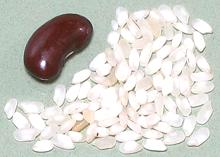 A very tiny medium grain rice used in southern India to make small steamed
cakes called Idli, and lacy crepe like pancakes called Dosa. The photo
specimens were typically 0.190 inch long and 0.090 inch wide (4.8 x 2.3 mm).
This rice is usually parboiled but sometimes not, and some people use
most parboiled and some not, especially for Dosa. You can cook this rice
normally, but use a little shorter time due to the small grains, and
perhaps just a touch less if it's parboiled. This rice is generally
not cooked normally.
A very tiny medium grain rice used in southern India to make small steamed
cakes called Idli, and lacy crepe like pancakes called Dosa. The photo
specimens were typically 0.190 inch long and 0.090 inch wide (4.8 x 2.3 mm).
This rice is usually parboiled but sometimes not, and some people use
most parboiled and some not, especially for Dosa. You can cook this rice
normally, but use a little shorter time due to the small grains, and
perhaps just a touch less if it's parboiled. This rice is generally
not cooked normally.
Idli rice is usually soaked for 6 hours or more, ground to paste
in a wet grinder, and combined 3:1 with similarly ground urad dal
and other ingredients, fermented at least overnight (depending on
the climate) and then steamed in a special idli steamer. The batter
is made a little thinner for Dosa, which are pan fried. Subst:
substitution is risky. The rice needs to be parboiled and have an
amylopectin content of 80% or higher. Long grain rice is 78% or less
and won't work.
 This is a new variety highly though of for making idli and dosa. This
rice is sold in parboiled form, and its usage is precisely the same
as Idli Rice. The photo specimens were 0.27
inch long and 0.07 wide (6.9 x 1.8 mm).
This is a new variety highly though of for making idli and dosa. This
rice is sold in parboiled form, and its usage is precisely the same
as Idli Rice. The photo specimens were 0.27
inch long and 0.07 wide (6.9 x 1.8 mm).
 [Thai Basmati; Hom Mali (Thai); Milagrosa (Philippines); Cambodia Fragrant;
Oryza sativa var Indica]
[Thai Basmati; Hom Mali (Thai); Milagrosa (Philippines); Cambodia Fragrant;
Oryza sativa var Indica]
This long grain and distinctly aromatic rice from Thailand has penetrated the Indian market, as it has everywhere else. India brands, like "Pride of India" import it from Thailand, but much is grown in Vietnam, and Cambodia is also a significatnt exporter. This rice is 15% to 18% amylose.
Sometimes called "Thai basmati", this rice remains fluffy with separate
grains when properly cooked (usually by absorption method), though it is
stickier than Basmati. It can be a resonable substitute for South Indian
rice in regions where those varieties of rice are not available. 1 cup
rice needs about 1-3/4 cups of water (variable depending on age) to makes
about 3 cups cooked rice in 25 minutes. The photo specimens were typically
0.300 inches long and 0.075 inches wide (7.6 x 1.9 mm).
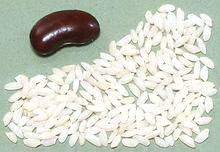 [Muthu Samba]
[Muthu Samba]
This tiny rice was once known as the "Prince of Rice" in Bengal, India and used for celebrations of all kinds. The name means "black cumin" due to the unmilled rice's resemblance to the spice. It has become scarce since the main rice growing region of Bengal was split off to form East Pakistan, now Bangladesh. Bangladesh is very poor and overpopulated, so many rice growers switched to high yield varieties.
This rice has recently (2021) become more available and more affordable
in North America. I have seen it at 2021 US $2.48 / pound from Bangladesh
and $6.70 / pound from Bengal. In 2013 it was about 2013 US $10 / pound
plus shipping. The photo specimens were from Bengal, 0.170 inch long and
0.072 inch wide (4.3 x 1.8 mm). Subst:
Jeera Samba still grown in good quantity in Tamil Nadu and
relatively economical.
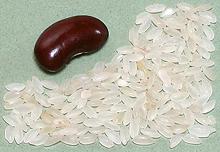 [Steamed Samba Rice]
[Steamed Samba Rice]
A tiny grained rice grown in Sri Lanka (was Ceylon). It is available in
Red, White, and White Boiled. The boiled version has a slightly yellowed
color and a distinct aroma absorbed from the husks. It doesn't bother me,
but some have been quite taken aback and thought the rice somehow spoiled.
Some find the aroma objectionable. One who did, found it objectionable
plain or made into idlis but quite to her liking when used to make dosas.
This rice cooks into separate non-sticky grains. One cup of this rice
needs 1-3/4 cups of water and cooks in about 20 minutes. The photo
specimens, from Sri Lanka, white boiled, were typically 0.155 inch long
and 0.060 inch wide (4.7 x 1.8 mm).
 Meaning "Soft Rice", this is a type of sweet rice (Bora saul) unique
to Assam. It is made fluffy and edible by a moderate time soaking in water,
and is not cooked - actually, it's already cooked. To make it, Bora Saul,
immediately after harvesting, is soaked overnight. It is then boiled and
sun dried. It is, of course, a light brown rice, as it is not polished.
Photo borrowed from IndiaMart / Sanscriti until I can get
samples in North America.
Meaning "Soft Rice", this is a type of sweet rice (Bora saul) unique
to Assam. It is made fluffy and edible by a moderate time soaking in water,
and is not cooked - actually, it's already cooked. To make it, Bora Saul,
immediately after harvesting, is soaked overnight. It is then boiled and
sun dried. It is, of course, a light brown rice, as it is not polished.
Photo borrowed from IndiaMart / Sanscriti until I can get
samples in North America.
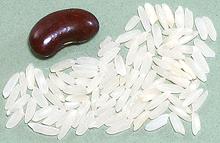 This is a type of long grain rice grown near the city of Patna in
northeastern India. It is not as distinctive as the Basmati grown farther
to the West, much less aromatic, a bit shorter and without Basmati's
distinctive lengthwise expansion in cooking. Once widely exported, Patna
became somewhat of a generic term for long grain rice. You can use Patna
type rice where the rice will be distinctly spiced and seasoned, or mixed
with other ingredients. Use Sona Masoori
or Thai Jasmine where the rice will stand on
its own. The photo is of American Long Grain Patna Type Rice as Indian
Patna was not available - the U.S. is a huge exporter of this type of
rice, not an importer.
This is a type of long grain rice grown near the city of Patna in
northeastern India. It is not as distinctive as the Basmati grown farther
to the West, much less aromatic, a bit shorter and without Basmati's
distinctive lengthwise expansion in cooking. Once widely exported, Patna
became somewhat of a generic term for long grain rice. You can use Patna
type rice where the rice will be distinctly spiced and seasoned, or mixed
with other ingredients. Use Sona Masoori
or Thai Jasmine where the rice will stand on
its own. The photo is of American Long Grain Patna Type Rice as Indian
Patna was not available - the U.S. is a huge exporter of this type of
rice, not an importer.
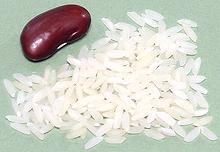 [Ponni Pachai Arisi (raw), Ponni Puzhungal Arisi (par boiled);
Oryza sativa var Indica]
[Ponni Pachai Arisi (raw), Ponni Puzhungal Arisi (par boiled);
Oryza sativa var Indica]
This rice, developed in Tamil Nadu in 1986, has become extremely popular in southern India. Caution: advertisements on the Internet often say "Ponni Raw Rice", but then describe it as boiled, thus it is actually Puzhungal, which has a slightly darker color. It must be truely "raw" for most Tamil Nadu breakfast items, but Puzhungal is good for Idli and Dosai (often some raw mixed in for the Dosai).
Ponni is a name for the Kaveri river near which this rice is grown.
This rice is now a major export crop in Tamil Nadu, largely to Southeast
Asia, Europe and North America. Ponni has good taste and texture, but is
not an aromatic rice. It is a small but very long grain rice - typically
0.21 inch long, 0.06 inch wide, and 0.07inch thick (5.3 x 1.5 x 1.8 mm).
1 cup rice needs about 1-3/4 cups (variable depending on age) of water to
makes about 3 cups cooked rice in 25 minutes.
 [Puri, Mudhi, Murmuri, Pori (India); Muri (Assam); Mamra (Gujarat)]
[Puri, Mudhi, Murmuri, Pori (India); Muri (Assam); Mamra (Gujarat)]
A minor product in North America, Puffed and Popped rice are very
popular all over India, used to make Chaat (snack dishes), sweets, and
desserts. These products are made by several methods, gun puffed (North
America) and puffed / popped in a bed of hot salt (Indian traditional)
and oven puffed (India).
Details and Cooking.
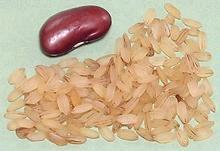 [Palakkadan Matta, Kerala Matta, Kaje Rice] This rice is grown
mainly in the Palakkad region of central Karala, southwest India. It is
sold as a parboiled rice, boiled before husking and milling. It is much
more nutritious than white rice and has significant fiber, which white
rice does not have. Grains are typically 0.21 inch long, 0.11 inch wide
and 0.07 inch thick (5.3 x 2.8 x 1.8 mm). It appears to be a good
substitute for Goa Red Rice which is much less
available in North America.
[Palakkadan Matta, Kerala Matta, Kaje Rice] This rice is grown
mainly in the Palakkad region of central Karala, southwest India. It is
sold as a parboiled rice, boiled before husking and milling. It is much
more nutritious than white rice and has significant fiber, which white
rice does not have. Grains are typically 0.21 inch long, 0.11 inch wide
and 0.07 inch thick (5.3 x 2.8 x 1.8 mm). It appears to be a good
substitute for Goa Red Rice which is much less
available in North America.
This rice needs a lot of water (1 cup rice to 4 cups water)
and a long cooking time. Steamed on the stovetop or in a Rice Cooker will
take about 1-1/4 hours. Pressure cookers are very popular in India, and
here are the instructions for that. Wash rice and place in the cooker with
water (1 cup rice to 4 cups water). Over high heat, wait until steam is
escaping through the vent, then drop down the weights. After 3 whistles
(more, whistle if your stove is very hot) turn off the heat and wait for
the pressure to go down (10 to 15 minutes).
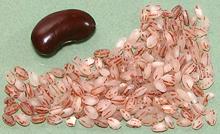 This is a "brown rice" version of the tiny Samba rice. Like other Samba
rices it is grown in Tamil Nadu and Sri Lanka. This rice is pleasant
and quite mild, between a white rice and most brown rice. One cup of
this rice needs about 1-3/4 cups of water and cooks in about 30
minutes. The photo specimens, from Sri Lanka, were typically 0.150
inch long and 0.072 inch wide (4.6 x 2.2 mm).
This is a "brown rice" version of the tiny Samba rice. Like other Samba
rices it is grown in Tamil Nadu and Sri Lanka. This rice is pleasant
and quite mild, between a white rice and most brown rice. One cup of
this rice needs about 1-3/4 cups of water and cooks in about 30
minutes. The photo specimens, from Sri Lanka, were typically 0.150
inch long and 0.072 inch wide (4.6 x 2.2 mm).
 [Jeera Samba, Jeeraga Samba]
[Jeera Samba, Jeeraga Samba]
A very tiny grained aromatic rice grown in the Indian province of Tamil Nadu and preferred for making Biriyani in that region (basmati is used elsewhere). It is the most expensive rice grown in Tamil Nadu, and is named after Seera (Jeera, Cumin) because the tiny grains are thought to resemble cumin seed. It is very similar to the once very prestigious Kalijeera rice of Bangladesh, now uncommon. Tamil Nadu still grows plenty of Jeera.
This rice cooks fluffy with very separate grains, with excellent
flavor and aroma. I find it a very fine rice for serving plain as
well as in recipes. The photo specimens were typically 0.160 inch
long and 0.070 inch wide (4.9 x 2.1 mm). A cup of this rice needs
about 1-3/4 cup water and cooks in about 20 minutes.
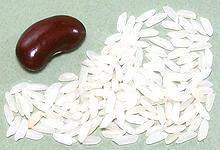 [Sona Masuri, Samba Masuri, BPT 5204, HMT, Jeela Karra Masur]
[Sona Masuri, Samba Masuri, BPT 5204, HMT, Jeela Karra Masur]
This rice, grown in the states of Andhra Pradesh and Karnataka, was the
most favored rice in southern India, until the comming of Ponni. In the
north it is used where basmati is too expensive. It is an excellent long
grain rice of medium size, and the grains stay fluffy and separate. One
cup of rice will need 1-3/4 cups of water and will cook in 25 minutes.
The photo specimens were 0.215 inch long and 0.072 inch wide
(6.6 x 2.2 mm).
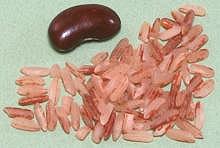 This rice is grown in the island nation of Sri Lanka and in the far
southeast coast of India nearby. I very much like this rice, with it's
earthy aroma and taste. It is an excellent choice when plain brown
rice is just too plain. One cup of rice takes a shade over 2 cups of
water and is done in about 35 minutes, faster than most brown rice.
The photo specimens were 0.265 inch long and 0.070 inch wide
(6.7 x 1.8 mm).
This rice is grown in the island nation of Sri Lanka and in the far
southeast coast of India nearby. I very much like this rice, with it's
earthy aroma and taste. It is an excellent choice when plain brown
rice is just too plain. One cup of rice takes a shade over 2 cups of
water and is done in about 35 minutes, faster than most brown rice.
The photo specimens were 0.265 inch long and 0.070 inch wide
(6.7 x 1.8 mm).
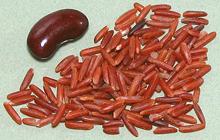 This rice does not resemble Indian Basmati in any way, except for the
grains being long and thin. These grains are, however, much smaller,
measuring about 0.275 inch long by 0.060 inch diameter (7.0 x 1.5 mm).
It also does not much resemble the Sri Lankan Red Rice above, in that
it is darker, takes about 2-1/4 cups of water per cup of rice and
takes much longer to cook, about 50 minutes. It is also less earthy
in aroma and taste.
This rice does not resemble Indian Basmati in any way, except for the
grains being long and thin. These grains are, however, much smaller,
measuring about 0.275 inch long by 0.060 inch diameter (7.0 x 1.5 mm).
It also does not much resemble the Sri Lankan Red Rice above, in that
it is darker, takes about 2-1/4 cups of water per cup of rice and
takes much longer to cook, about 50 minutes. It is also less earthy
in aroma and taste.
 [Bora saul (Assam); Kao hnyin (Burma), Khao niao (Laos); Khao niao,
Khao nueng (Thai); Gao Nep (Viet)]
[Bora saul (Assam); Kao hnyin (Burma), Khao niao (Laos); Khao niao,
Khao nueng (Thai); Gao Nep (Viet)]
Bora saul sweet rice is much used in Assam state in the far northeast
of India. Pancakes, snacks and sweets are made from it. Development of a
commercially available beer made with Bora saul is in process, and it has
long been used for home brewed beer. Bora saul is pretty much the same as
Thai Long Grain Sweet Rice. The photo specimens are from Thailand and
were 0.255 inch long by 0.090 inch wide (6.5 x 2.3 mm). There is also
a black version called Kola Bora Saul. Assam is a rice exporting region,
so this rice is probably exported to other parts of India, where small
amounts are used for specific purposes.
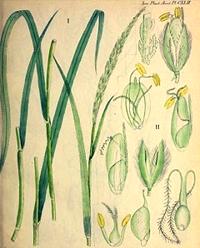 [Porteresia coarctata syn. Oryza coarctata]
[Porteresia coarctata syn. Oryza coarctata]
This is a very salt tollerant, perennial wild rice that grows in saline
estuaries and mangrove forrests in India, Bangledesh, Sri Lanka, and
Burma. In its growing region it is wild harvested and eaten as a delicacy.
It is considered a very important genetic resource for breeding salt
tolerant and perennial varieties of cultivated rice.
Drawing presumed copyright expired.
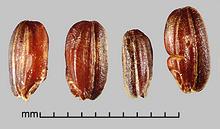 [Oryza rufipogon and hybrids]
[Oryza rufipogon and hybrids]
Various varieties of this wild rice are a difficult to eradicate crop pest
of no commercial value. The seed heads of these varieties tend to shatter
(ripen unevenly and spill their seeds as they ripen). If seeds make into the
harvest, consumers may think they are spoiled, or not really rice, and they
take nutrients intended for the crop. They are listed as "noxious weeds"
in several US States, but these wild varieties are used by plant geneticists
developing new commercial rice varieties.
Photo by Julia Scher, Federal Noxious Weed Disseminules of the
U.S. (Federal Government) = public domain.